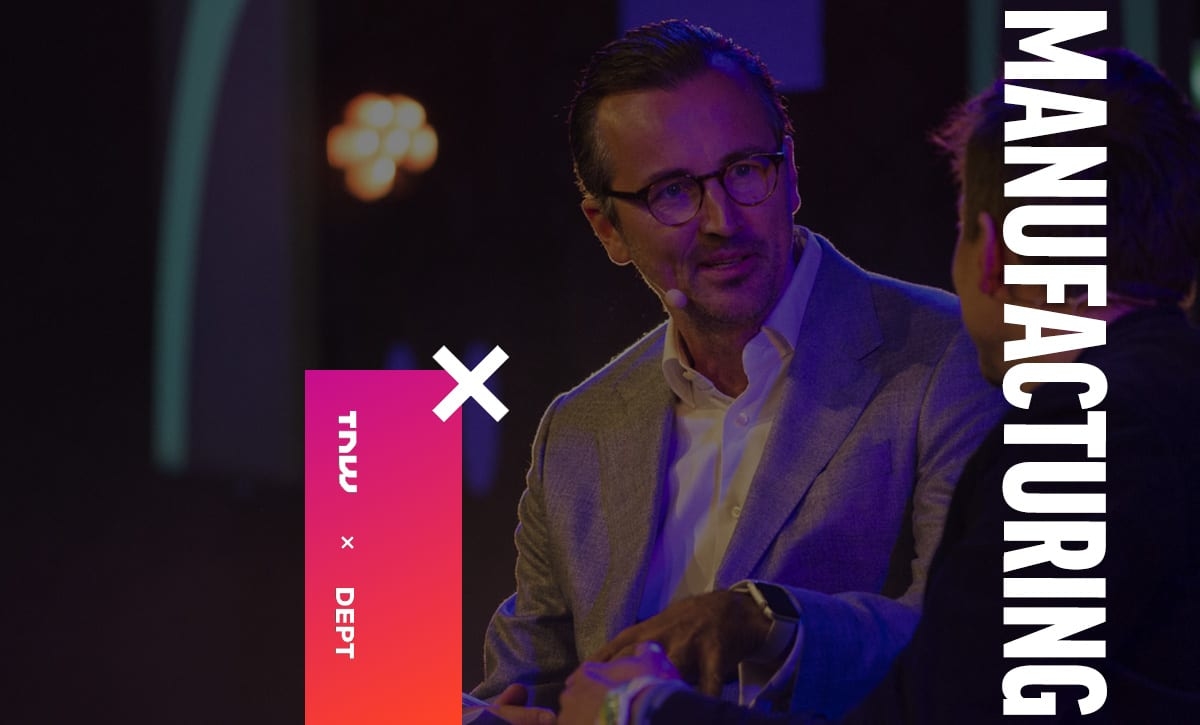Accelerating the future of manufacturing: TNW panel

DEPT® recently hosted a Manufacturing panel discussion at The Next Web, Europe’s largest technology event. Moderator Jonathan Whiteside, DEPT®’s Principal Consultant, was joined by Kim Walowsky, Hilti Group’s Head of Digital & Brand in Northern Europe, Rachel Hughes, Marketing Director at Wienerberger UK, and Guy Magrath, Former CDO of Electrocomponents. Each panelist offered viewpoints, experiences and opinions on how manufacturing businesses can adapt for recovery and growth in the market’s current climate.
What are the big trends happening in the manufacturing sector at the moment in regards to the digital impact on the customer experience. Do you think they are temporary or here to stay?
Guy Magrath set the scene with stats around the B2B buying journey: “61% of B2B buyers are predominantly doing research and finding products online, this is a 50% increase from three years ago. This has been driven by the millennial audience, which accounts for 30% of the workforce, and buyers being highly aligned to this audience. By 2030, millennials will account for 70% of the workforce. COVID has further accelerated the shift to digital.”
Magrath offered his take on aspects to consider when companies shift focus to digital markets: “The first and most important is ease of use. People are short on time, so the easier it is to use, the more convenient customer loyalty becomes. Make it incredibly friendly and make the journey relevant. Lastly, make it quick. This isn’t just a reference to site spee; offer same day delivery, not next day delivery.”
Rachel Hughes believes less face-to-face selling and an increased reliance on virtual forums is here to stay. “Time spent visiting customers is almost like a currency; when it’s limited, it’s better spent doing something the customer values, such as helping to understand their issues and solve a problem, rather than arriving with a catalogue of products.” She went on to explain, “in many manufacturing businesses, B2B is playing catch up to B2C and, for us, COVID has seen the welcome acceleration of projects such as customer portals, online account management, and sales enablement tools like ShowPad.”
Kim Walowsky expanded on Rachel’s comments by adding the details of her own personal experience, “fundamentally, there is no difference between a good customer experience in B2B and B2C, it is just a lot more complex. A good experience is one that is either frictionless or positively memorable.”
Walowsky summed up the levels of complexity in B2B in three main points: serving multiple, often interdependent contacts within a business; creating touch-points across various channels within the organisation (online, customer services, direct sales, resellers); keeping up with consumer expectations and providing them with the types of experiences they expect.
Walowsky advises fellow manufacturers to focus on: understanding the needs of the different stakeholders within your customer origination; creating a way to gain transparency on all the customer touchpoints, and to start working on ‘hero journeys’ important to your customer contact that would benefit the most from improvements.
How can Manufacturers explain complex physical products and services remotely?
Walowsky highlighted that this is a big challenge for the manufacturing sector, especially when selling solutions and non-tangible items. She shared an approach Hilti has taken to tackle this challenge: “ We have recently launched #HiltiLive where we use the live streaming functionality on social media to demonstrate our solutions and interact with our customers and prospects.”
Hilti’s solution produced results two-fold, as it both attracted new talent and a new generation of consumers to business. Walowsky cited examples of how this has been achieved, “we have started using VR to show managers some of the challenges that are being faced on their job sites involving manual record keeping, and what an optimal solution could look like. Many digital natives within our organisations loved using the tool to open conversations, and it also evoked customers’ curiosity.”
The obstacles created by COVID have eliminated the ability for companies to rely on trade shows and face-to-face events which, up until six months ago, were the ‘go to’ solutions for companies to announce product launches. “Virtual training, product launches, webinars and CPDs over Zoom have forced us to be more creative and entertaining in our delivery. It also needs to be carefully targeted – customers don’t generally wander by when it’s a virtual event,“ said Hughes.
Fortunately for Wienerberger UK, the use of ‘fly throughs’ showing 3D architectural building design for its services to housing developers, was not a new concept. When there is a need to show a physical product, Hughes explained, “we use texture generators and high definition panel imagery to show architects and specifiers the product in a virtual setting. It has its place, and has worked well in the past six months because there was no alternative. However, people still like to touch and feel a product when they’re at the ‘selection’ stage, but they’re a lot more accepting of a purely virtual experience when fact finding and exploring.”
Though this has not been an easy feat, this fast switch to digital has forced many companies to re-examine their processes and quality control of data. “It’s more critical than ever to have a deeper understanding of the customer’s issues and to remain relevant in that picture. You must be able to sell the benefits of the solution you offer, not just features,” emphasised Hughes. She also added, “those who are ready with a digital first approach will be the winners.”
What are your thoughts on Direct-to-Consumer models, and the long term impact this could have on your relationships with your resellers and distribution channel?
It’s not hard to imagine that lockdown for Wienerberger UK yielded a tremendous influx of homeowner enquiries and an increase in demand for product samples. Instead of bi-passing their reseller network, Hughes explained, they invested in this area: “We have a strong reseller network in place through our builder and roofing merchants. They are crucial in the supply chain in that they have strong relationships, trust, have deep expertise in their field, and are good at what they do. Our online ‘find a stockist’ feature has been enhanced, we are improving our branch incentive model, and where we can no longer rely on PoS and merchandising, we are supporting them through virtual training and technical support – giving them things they value – as well as a good quality product range.”
“When you have increasingly digital savvy consumers, we recognise that our role is to act as an influencer and there is a lot we can do to raise our profile and deliver engaging and informative content – warming up the end customer for our distribution network so they know what to look for,” said Hughes in closing.
How can organisations do more with less?
With constant pressure from the ‘top’ to find new ways for digital to enable doing more with less, Rachel Hughes sheds light on how manufacturers can improve efficiencies and reduce costs. With the increase in digital demands and interactions, it only makes sense that automation, machine learning and AI will follow suit, “automation augments what humans do – it does not replace them,” said Hughes. “By using process automation, such as increasing the proportion of digital order entry by removing the manual processing of delivery notes, we allow customer agents to focus on advising and guiding customers, imparting expertise and upselling.” Implementing these concepts means less ‘grunt work’ for employees, freeing their attention to focus on what really matters: the customer.
Hughes further put forth, “we switched hauliers to non-touch collection processes in yards and did bookings and collections digitally rather than paper in triplicate.” These measures equate to much more than monetary savings. Transferring to paperless, forgoes the hassle of not just completing but storing mounds of endless paperwork, with the effortless fluidity of click, swipe, send. It saves both customer and employee time adding to the convenience of the experience. Additionally, going paperless saves natural resources, a bonus for the environmentally conscious company. And what once required countless square footage of file cabinet storage, can now easily fit in a small box in the shape of server storage.
With the forced move to remote working, how can you keep your people motivated?
The current impossibility of gatherings has proven to be a hurdle for employee engagement. Guy Magrath explained that purpose reigns supreme, “not having the ability to physically bring people together means the company’s purpose plays a key role in engaging employees. If businesses cannot find a way to connect employees with company purpose then there is no reason for the employee to stay. So it would seem the employee experience is just as important as the customer journey.”
Kim Walowsky commented on Hilti’s approach to retaining staff: “initially, our focus was on the health and safety of our own teams and supporting and servicing our customers. We then established a solid IT infrastructure, extended online collaboration platforms, trained the team heads on leading teams remotely, and placed an increased focus on mental health. Teams were quite creative, delivering virtual Health & Safety training, online Engineering Consultations and virtual formats to exchange and support each other.”
Walowsky further explained how the company focussed on its customers: “from a customer service perspective, the focus was on securing our supply chain and finding ways to support our customers through the crisis. We have learned the ‘art of the possible’ and will definitely look at creating an even more flexible working environment post-COVID and optimise how we deliver our services.”
Watch the full panel discussion
More Insights?
View all InsightsQuestions?
Global SVP Technology & Engineering



